Sakon Awarded 2019 Entrepreneurial Company of the Year Award by Frost & Sullivan
Background and Company Performance
Industry Challenges
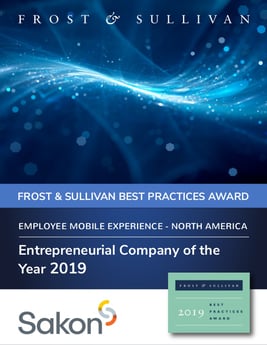
Rapid changes are taking place in how employees want and need to work, influenced by increasingly high expectations for the user experience. Companies have struggled with the fact that today’s workers expect, even demand, much more from their enterprise mobile experience. And while managing mobile employees and their devices has always been a challenge for the enterprise, the variety of today’s device ownership models and growing centrality of mobility in a business’ success have made things increasingly complex. Employees expect a great user experience and high quality support whether they’re using a company-owned mobile device (“corporate liable”) or one they have brought from home (BYOD).
Regardless of who owns the device, the enterprise must manage it, and do so within a mobile-first, gig economy, as well as budget – a feat much harder than it sounds. An increasingly complex mobile ecosystem combined with a lack of expertise inside too many enterprises means that businesses are now looking outside for expertise. Yet very few tools today focus on simplifying and automating operations as well as delivering quality end-user experiences. Meanwhile, managed mobility services (MMS) is estimated to be the fastest growing segment in enterprise managed communications services, by some accounts growing from close to $6.5 billion to $9.5 billion from 2018 to 2022.
Entrepreneurial Innovation and Customer Impact
Sakon is a leading SaaS-based platform for managing enterprise communications services. It has helped global enterprises organize, understand, and intelligently manage their communications and cloud services since 2003. Headquartered in Concord, Massachusetts,
with a global delivery center based in Pune, India, it has more than 500 employees. The company services over 220 enterprise customers, and its technology is used by some of the top systems integrators and outsourced services providers across the globe. It’s
involved in transformational projects with CSPs, SIs, and ITOs such as IBM.
Sakon manages global communications inventory (wireline, network, wireless, IoT, SaaS) usage and cost optimization, sourcing, and supports network transformation. It has integrated Mobile Device as a Service (MDaaS) and BYOD offerings as ways to enable the transition of enterprises away from device ownership. The company is a global alliance partner with IBM, working on network transformation initiatives (e.g. transitioning from an MPLS data network to SD-WAN). In short, Sakon helps enterprise customers understand, manage, and transform their communications infrastructure.
Sakon sells direct and through partners, reports consecutive years of 40% YOY organic growth, and is profitable and self-sustaining, with no venture capital funding and no acquisitions, which translates into a continuity of vision, technology, and service delivery that benefits customers. Today it is winning direct clients through its three practice areas of TEM, Network Services, and MMS. And when it comes to MMS specifically, what is particularly intriguing to Frost & Sullivan is the way in which Sakon is helping innovate the employee mobile experience through its new Sakon Mobility App.
Market Disruption
When it comes to MMS, Sakon has been working behind the scenes for years. Today, however, the company feels that (based in part on what an array of current clients have been telling them) that the moment to disrupt that market has arrived. For Frost & Sullivan, Sakon’s innovative and first-to-market mobile management application (successfully beta tested with thousands of users in Fortune 500 environments) has genuine potential to disrupt the enterprise communications services market, shaking up the competition. As Sakon points out, the new solution provides everything employees need to manage their corporate mobile experience with a simple click, swipe, or voice activated command.
No competitor appears to be out in the market with a purpose-built mobile application to manage the employee mobile experience amidst a constantly shifting mobility environment – offering deep end-user enablement – quite like Sakon. Sakon is also unique in that it has considerable experience seeing and analyzing other companies’ systems while also being able to orchestrate between multiple providers. The concept of "service orchestration," seamlessly orchestrating data flows between customer and provider systems, enables complete management of the mobility lifecycle and end-user experience. And as mobility grows ever more complicated, and ever more critical to business success, enterprises need this expert, full-lifecycle-management capability and agility to support a growing number of devices. Right now, these types of functionalities appear to be something only Sakon can do.
And while Sakon’s Mobility App empowers employees with a seamless mobile experience conveniently managed on their own devices, it also reduces strain on IT resources and program administrators. This is to say that it’s convenient and easy for the end-user (all the orchestration happens in the background) while also offering businesses the ability to better understand the end-user. In effect, the Sakon Mobility App pushes key information out to users while also bringing a range of information back into businesses in order to help those businesses make decisions and be more familiar with their own environment. For Frost & Sullivan, the Sakon platform is not only about the orchestration of the modern workforce, but enabling the future of work itself.
Market Gaps
Most of Sakon’s competitors in MMS generally come from the help desk and logistics industries. As such, their business models are fundamentally different from Sakon’s entrepreneurial vision; a technology of automated workflows that reduces the requirement for help desk is not necessarily what these kinds of competitors want to offer clients, and neither are they interested in simplifying the end-user experience for those clients. Sakon is stepping into that gap – its solution takes clients from a world of disconnected point solutions (help desk, logistics center, MDM platforms, TEM, staging & kitting, break fix, and other providers) to a world where data is orchestrated within mobility source systems, mobility use cases are automated, and the end-user experience is simplified.
When it comes to mobile employees across the globe, Sakon has a clear understanding of its enterprise customers’ set of desired outcomes and the gaps that currently exist in achieving them. And for Sakon, this also means addressing the strategic gap that far too many organizations have long struggled with (and that some have even overlooked entirely) – delivering today’s employees an exceptional mobile experience.
The Sakon Mobility App can be installed on employees’ mobile devices (everything from Android to Apple) in order to radically simplify the experience of enterprise mobility by putting end-users in control of their enterprise mobile experience, from the convenience of their own devices. By placing the power of mobility management directly into the hands of those end-users, the app helps drive increased satisfaction and increased productivity.
Passionate Persistence
Sakon got its start as a knowledge center and provider of services in the telecom expense management (TEM) space back in 2003, cutting its teeth on a complex business in an industry characterized by frequent mergers and acquisitions. The company’s consistency of vision and focus persisted over the years that followed, and, arguably, the experience gained in the management of mobile voice and data services is what sets Sakon apart today.
Sakon also has spent the past few years responding to a shifting market landscape impacted by disruptive digital transformation, pursuing its mobility app in both a creative and disciplined manner. The result is an application that leverages the totality of the company’s years of distant and recent experience successfully orchestrating enterprise mobility services on its mobility platform for some of the world’s largest MMS providers and Fortune 500 customers.
Based on a passion to simplify the mobile environment and create a mobility app that would be with the user wherever he or she goes, taking care of them, getting them to whatever service desk they need, Sakon developed an API framework to orchestrate all
automated workflows and provide a seamless user experience anywhere, from devices to web portals. And Sakon is different in the way it leverages its application programming interface (API) framework, with APIs that mesh with bot APIs while managing data and insights (a process of “flow and intent”) that captures and provides data anywhere it is needed. And the Sakon Mobility App is language agnostic, meaning it can adapt to foreign language bots using its API framework to feed and receive information.
Customer Purchase Experience
With Sakon, enterprises feel they are buying a solution that addresses both their unique needs (i.e., delivering employees an optimal mobile experience, from simplified onboarding and service requests, to supporting BYOD and automated stipend payments) and their unique constraints and challenges in a highly competitive digital work environment where the race for talent and improved productivity is unrelenting.
Sakon’s competitors simply do not appear to offer the features the Sakon Mobility App possesses nor the expert capabilities of the Sakon platform. From day one, Sakon orchestrates others’ services, its platform manages and governs data it can capture from anywhere, and orchestrates the workflows in the full blown mobility environment.
As such, the strategic components of the Sakon platform go a long way toward buttressing the customer purchase experience. Those strategic components include the following:
- Ownership Agnostic Toolset. A single platform to manage all ownership models
– BYOD, CYOD, leased, corporate-owned. - Business Intelligence & Analytics. The ability to understand the entire mobility ecosystem in order to enhance strategic decision making.
- Intelligent Support Orchestration. The ability to ensure best-of-breed support globally.
- Modern Conversational Channels. Simplifying transactions through context sensitive chatbots and other tools.
- Governance and Compliance Management. Integrating with UEM data to improve compliance.
- Cost Management. Able to audit, allocate, and optimize device and service costs.
Customer Ownership Experience
Sakon’s solution integrates with all major OEM providers and other platforms, across all use cases. It has been successfully beta tested with thousands of users in Fortune 500 environments. Those users have reported a positive experience due in large part to the following specific advantages of the platform:
- Simplified Onboarding. Registering users onto a corporate app is too often tedious and unnecessarily complicated. But Sakon’s conversational UX makes the registration process easy and is designed to keep users engaged and focused. The onboarding process starts by getting the user on the corporate program, the BYOD program, etc. Users can even choose the verbiage.
- Mobility in One Dashboard. Devices, services, applications, and costs can be glimpsed in an instant, and information can be customized based on the program. The dashboard provides a range of options, removing all friction for the employee (as in the consumer world). It’s convenient to see all costs and additional data.
- Help Center. Users can access help when needed, as the Help Center can be scheduled so a representative is ready during the best part of a user’s day, or can be made available on-demand.
Customer Service Experience:
Based on the beta test of Fortune 500 users, customer service is accessible, fast, stress free, and of high quality. It starts with the gathering of data, verifying each user, and then interacts on corporate policies using chatbot technology.
The following advantages improve the CX:
- Simple, Effective Self-Service. Users are able to self-serve in a quick and seamless manner; it’s easy for users to change features, add international plans, disconnect, transfer out, or change a number.
- Anytime/Anywhere Virtual Assistant. The Virtual Assistant is smart and AI/ML powered. It identifies where users need help and then proactively suggests the best solution.
- Notifications Made Easy. The automated push-notification engine works in a non-intrusive, “behind the scenes” manner, to keep users up to date.
Conclusion:
Through the way in which it’s Mobility App is innovating the mobile user experience while orchestrating the modern workforce and even enabling the very future for work Sakon has earned Frost & Sullivan’s 2019 Entrepreneurial Company of the Year Award for the Employee Mobile Experience.
Significance of Entrepreneurial Leadership
Ultimately, growth in any organization depends on customers purchasing from a company and then making the decision to return time and again. In a sense, then, everything is truly about the customer. Making customers happy is the cornerstone of any successful long-term innovation or growth strategy. To achieve the dual goals of customer engagement and growth, an organization must be best in class in 3 key areas: understanding demand, nurturing the brand, and differentiating from competition.
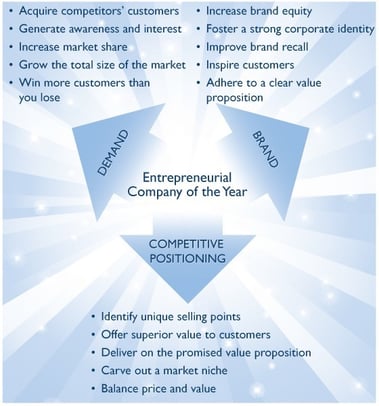
Understanding Entrepreneurial Leadership
Demand forecasting, branding, and differentiation underpin an entrepreneurial company’s journey toward forming deep relationships with customers and permanently altering the market with their actions. Entrepreneurial Innovation and Customer Impact are the cornerstones of this award, as discussed further in the next section.
Key Benchmarking Criteria
For the Entrepreneurial Company of the Year Award, Frost & Sullivan analysts independently evaluated Entrepreneurial Innovation and Customer Impact according to the criteria identified below.
Entrepreneurial Innovation
Criterion 1: Market Disruption
Criterion 2: Competitive Differentiation
Criterion 3: Market Gaps
Criterion 4: Blue Ocean Strategy
Criterion 5: Passionate Persistence
Customer Impact
Criterion 1: Price/Performance Value
Criterion 2: Customer Purchase Experience
Criterion 3: Customer Ownership Experience
Criterion 4: Customer Service Experience
Criterion 5: Brand Equity
Best Practices Award Analysis for Sakon
Decision Support Scorecard
To support its evaluation of best practices across multiple business performance categories, Frost & Sullivan employs a customized Decision Support Scorecard. This tool allows research and consulting teams to objectively analyze performance according to the key benchmarking criteria listed in the previous section, and to assign ratings on that basis. The tool follows a 10-point scale that allows for nuances in performance evaluation. Ratings guidelines are illustrated below.
RATINGS GUIDELINES

The Decision Support Scorecard considers Entrepreneurial Innovation and Customer Impact (i.e., the overarching categories for all 10 benchmarking criteria; the definitions for each criterion are provided beneath the scorecard). The research team confirms the veracity of this weighted scorecard through sensitivity analysis, which confirms that small changes to the ratings for a specific criterion do not lead to a significant change in the overall relative rankings of the companies.
The results of this analysis are shown below. To remain unbiased and to protect the interests of all organizations reviewed, Frost & Sullivan has chosen to refer to the other key participants as Competitor 1 and Competitor 2.

Entrepreneurial Innovation
Criterion 1: Market Disruption
Requirement: Innovative solutions that have genuine potential to disrupt the market, making current solutions obsolete and shaking up competition.
Criterion 2: Competitive Differentiation
Requirement: Deep understanding of both current and emerging competition to create and communicate strong competitive differentiators in the market.
Criterion 3: Market Gaps
Requirement: A clear understanding of customers’ desired outcomes, the products that currently help them achieve those outcomes, and where gaps exist.
Criterion 4: Blue Ocean Strategy
Requirement: Strategic focus on creating a leadership position in a potentially uncontested market space, manifested by stiff barriers to entry for competitors.
Criterion 5: Passionate Persistence
Requirement: A deep belief in the rightness of an idea and a commitment to pursuing it despite seemingly insurmountable obstacles.
Customer Impact
Criterion 1: Price/Performance Value
Requirement: Products or services offer the best value for the price, compared to similar offerings in the market.
Criterion 2: Customer Purchase Experience
Requirement: Customers feel they are buying the optimal solution that addresses both their unique needs and their unique constraints.
Criterion 3: Customer Ownership Experience
Requirement: Customers are proud to own the company’s product or service and have a positive experience throughout the life of the product or service.
Criterion 4: Customer Service Experience
Requirement: Customer service is accessible, fast, stress-free, and of high quality.
Criterion 5: Brand Equity
Requirement: Customers have a positive view of the brand and exhibit high brand loyalty.
Decision Support Matrix
Once all companies have been evaluated according to the Decision Support Scorecard, analysts then position the candidates on the matrix shown below, enabling them to visualize which companies are truly breakthrough and which ones are not yet operating at best-in-class levels.
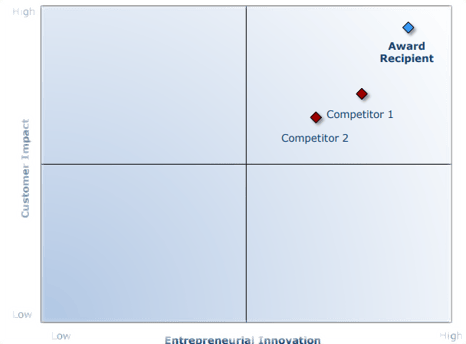
Best Practices Recognition: 10 Steps to Researching, Identifying, and Recognizing Best Practices
Frost & Sullivan analysts follow a 10-step process to evaluate award candidates and assess their fit with select best practice criteria. The reputation and integrity of the awards are based on close adherence to this process.
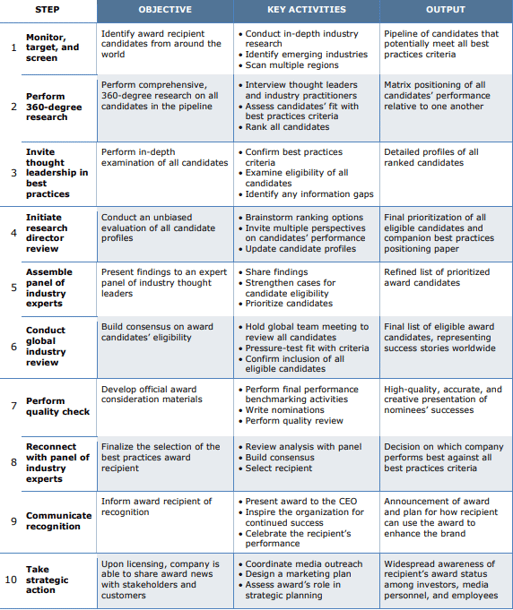
The Intersection between 360-Degree Research and Best Practices Awards
Research Methodology
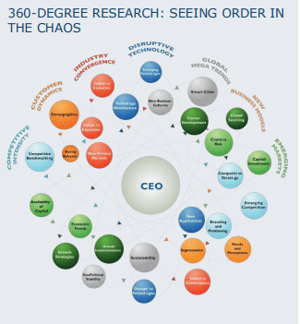
Frost & Sullivan’s 360-degree research methodology represents the analytical rigor of the research process. It offers a 360-degree view
of industry challenges, trends, and issues by integrating all 7 of Frost & Sullivan’s research methodologies. Too often companies make important growth decisions based on a narrow understanding of their environment,resulting in errors of both omission and commission. Successful growth strategies are founded on a thorough understanding of market, technical, economic, financial, customer, best practices, and demographic analyses. The integration of these research disciplines into the 360-degree research methodology provides an evaluation platform for benchmarking industry participants and for identifying those performing at best-in-class levels.
About Frost & Sullivan
Frost & Sullivan, the Growth Partnership Company, helps clients accelerate growth and achieve best-in-class positions in growth, innovation and leadership. The company's Growth Partnership Service provides the CEO and the CEO's growth team with disciplined research and best practices models to drive the generation, evaluation and implementation of powerful growth strategies. Frost & Sullivan leverages nearly 60 years of experience in partnering with Global 1000 companies, emerging businesses, and the investment community from 45 offices on 6 continents. To join Frost & Sullivan’s Growth Partnership, visit http://www.frost.com.
